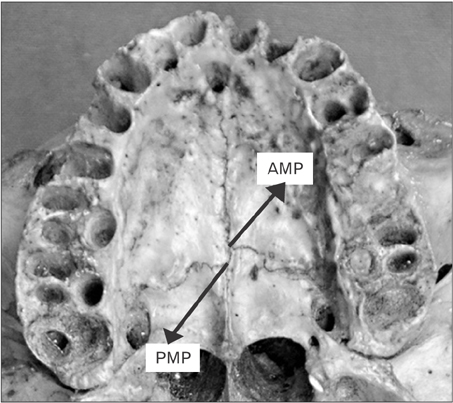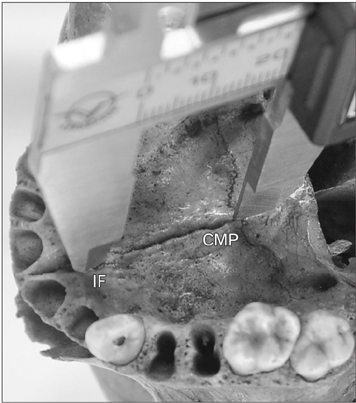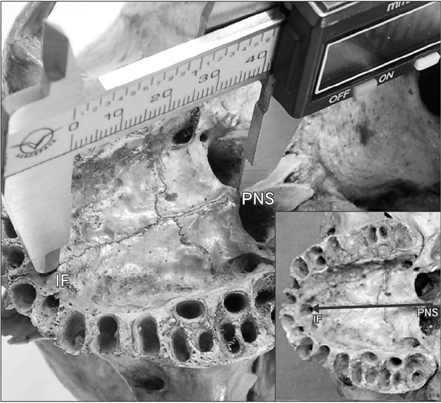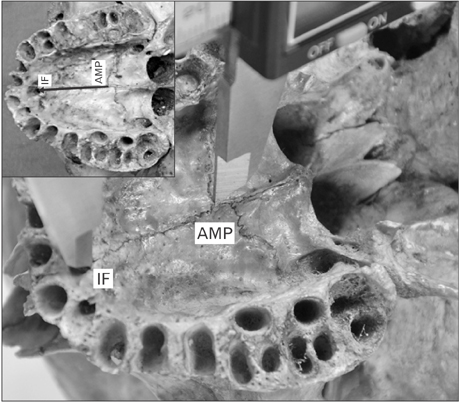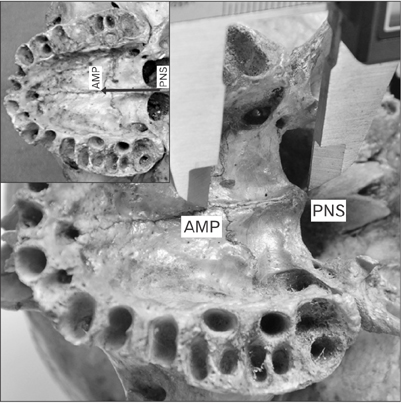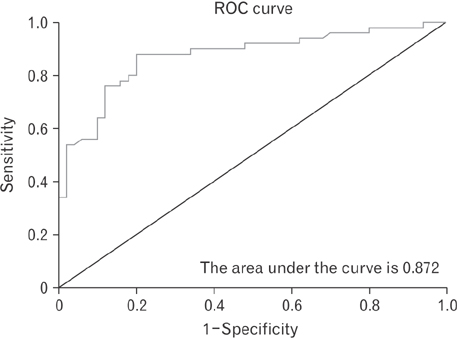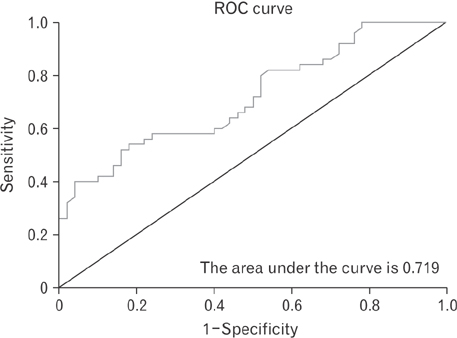Anat Cell Biol.
2016 Jun;49(2):151-159. 10.5115/acb.2016.49.2.151.
Binary logistic regression analysis of hard palate dimensions for sexing human crania
- Affiliations
-
- 1Department of Anatomy, Yenepoya Medical College, Yenepoya University, Mangalore, India. drvenkateshkamath@gmail.com
- 2Department of Anatomy, Kanachur Medical College, Mangalore, India.
- KMID: 2308923
- DOI: http://doi.org/10.5115/acb.2016.49.2.151
Abstract
- Sex determination is the preliminary step in every forensic investigation and the hard palate assumes significance in cranial sexing in cases involving burns and explosions due to its resistant nature and secluded location. This study analyzes the sexing potential of incisive foramen to posterior nasal spine length, palatine process of maxilla length, horizontal plate of palatine bone length and transverse length between the greater palatine foramina. The study deviates from the conventional method of measuring the maxillo-alveolar length and breadth as the dimensions considered in this study are more heat resistant and useful in situations with damaged alveolar margins. The study involves 50 male and 50 female adult dry skulls of Indian ethnic group. The dimensions measured were statistically analyzed using Student's t test, binary logistic regression and receiver operating characteristic curve. It was observed that the incisive foramen to posterior nasal spine length is a definite sex marker with sex predictability of 87.2%. The palatine process of maxilla length with 66.8% sex predictability and the horizontal plate of palatine bone length with 71.9% sex predictability cannot be relied upon as definite sex markers. The transverse length between the greater palatine foramina is statistically insignificant in sexing crania (P=0.318). Considering a significant overlap of values in both the sexes the palatal dimensions singularly cannot be relied upon for sexing. Nevertheless, considering the high sex predictability of incisive foramen to posterior nasal spine length this dimension can definitely be used to supplement other sexing evidence available to precisely conclude the cranial sex.
MeSH Terms
Figure
Reference
-
1. Durić M, Rakocević Z, Donić D. The reliability of sex determination of skeletons from forensic context in the Balkans. Forensic Sci Int. 2005; 147:159–164.2. Işcan MY. Forensic anthropology of sex and body size. Forensic Sci Int. 2005; 147:107–112.3. Patil KR, Mody RN. Determination of sex by discriminant function analysis and stature by regression analysis: a lateral cephalometric study. Forensic Sci Int. 2005; 147:175–180.4. Graw M, Wahl J, Ahlbrecht M. Course of the meatus acusticus internus as criterion for sex differentiation. Forensic Sci Int. 2005; 147:113–117.5. Goncalves D, Thompson TJ, Cunha E. Osteometric sex determination of burned human skeletal remains. J Forensic Leg Med. 2013; 20:906–911.6. Holland TD. Use of the cranial base in the identification of fire victims. J Forensic Sci. 1989; 34:458–460.7. Rogers TL. Determining the sex of human remains through cranial morphology. J Forensic Sci. 2005; 50:493–500.8. Mahakkanukrauh P, Sinthubua A, Prasitwattanaseree S, Ruengdit S, Singsuwan P, Praneatpolgrang S, Duangto P. Craniometric study for sex determination in a Thai population. Anat Cell Biol. 2015; 48:275–283.9. Lee JH, Kim YS, Lee UY, Park DK, Jeong YG, Lee NS, Han SY, Kim KY, Han SH. Sex determination using upper limb bones in Korean populations. Anat Cell Biol. 2014; 47:196–201.10. Williams PL, Bannister LH, Berry MM, Collins P, Dyson M, Dussek JE, Ferguson MW. Gray's anatomy. 38th ed. London: Churchill Livingstone;1995.11. Yemitan TA, Dacosta OO, Sanu OO, Utomi IL. Metric analysis of the hard palate in children with digit sucking habits. Odontostomatol Trop. 2013; 36:11–16.12. Rizell S, Barrenäs ML, Andlin-Sobocki A, Stecksén-Blicks C, Kjellberg H. Palatal height and dental arch dimensions in Turner syndrome karyotypes. Eur J Orthod. 2013; 35:841–847.13. Berwig LC, Silva AM, Côrrea EC, Moraes AB, Montenegro MM, Ritzel RA. Hard palate dimensions in nasal and mouth breathers from different etiologies. J Soc Bras Fonoaudiol. 2011; 23:308–314.14. Jung BA, Wehrbein H, Heuser L, Kunkel M. Vertical palatal bone dimensions on lateral cephalometry and cone-beam computed tomography: implications for palatal implant placement. Clin Oral Implants Res. 2011; 22:664–668.15. Kotrashetti VS, Hollikatti K, Mallapur MD, Hallikeremath SR, Kale AD. Determination of palatal rugae patterns among two ethnic populations of India by logistic regression analysis. J Forensic Leg Med. 2011; 18:360–365.16. Saraf A, Bedia S, Indurkar A, Degwekar S, Bhowate R. Rugae patterns as an adjunct to sex differentiation in forensic identification. J Forensic Odontostomatol. 2011; 29:14–19.17. Tomaszewska IM, Fraczek P, Gomulska M, Pliczko M, Sliwińska A, Sałapa K, Chrzan R, Kowalski P, Nowakowski M, Walocha JA. Sex determination based on the analysis of a contemporary Polish population's palatine bones: a computed tomography study of 1,200 patients. Folia Morphol (Warsz). 2014; 73:462–468.18. Ramamoorthy B, Pai MM, Prabhu LV, Muralimanju BV, Rai R. Assessment of craniometric traits in South Indian dry skulls for sex determination. J Forensic Leg Med. 2016; 37:8–14.19. Nishii Y, Sameshima GT, Mah JK, Enciso R, Takaki T, Sueishi K. Hard palate thickness for temporary anchorage devices placement: differences in sex and ethnicity. Orthod Waves. 2014; 73:121–129.20. Krag MH, Weaver DL, Beynnon BD, Haugh LD. Morphometry of the thoracic and lumbar spine related to transpedicular screw placement for surgical spinal fixation. Spine (Phila Pa 1976). 1988; 13:27–32.21. da Silva RH, de Oliveira RN. Forensic anthropology and molecular biology: independent or complementary sciences in forensic dentistry? An overview. Braz J Oral Sci. 2008; 7:1575–1579.22. Steyn M, Işcan MY. Sexual dimorphism in the crania and mandibles of South African whites. Forensic Sci Int. 1998; 98:9–16.23. Suazo GI, Zavando MD, Smith RL. Sex determination using mastoid process measurements in Brazilian skulls. Int J Morphol. 2008; 26:941–944.24. Kamath VG, Asif M, Shetty R, Avadhani R. Binary logistic regression analysis of foramen magnum dimensions for sex determination. Anat Res Int. 2015; 2015:459428.25. Monticelli F, Graw M. Investigation on the reliability of determining sex from the human os zygomaticum. Forensic Sci Med Pathol. 2008; 4:181–186.26. Bigoni L, Velemínská J, Brůzek J. Three-dimensional geometric morphometric analysis of cranio-facial sexual dimorphism in a Central European sample of known sex. Homo. 2010; 61:16–32.27. Nemzek WR, Brodie HA, Hecht ST, Chong BW, Babcook CJ, Seibert JA. MR, CT, and plain film imaging of the developing skull base in fetal specimens. AJNR Am J Neuroradiol. 2000; 21:1699–1706.28. Moore Jansen PM, Ousley SD, Jantz RL. Data collection procedures for forensic skeletal material. Knoxville, TN: Department of Anthropology, University of Tennessee;1994. p. 45–51.29. Nascimento Correia Lima N, Fortes de Oliveira O, Sassi C, Picapedra A, Francesquini L Jr, Daruge E Jr. Sex determination by linear measurements of palatal bones and skull base. J Forensic Odontostomatol. 2012; 30:38–44.30. Francesquini Júnior L, Francesquini MA, De La Cruz BM, Pereira SD, Ambrosano GM, Barbosa CM, Daruge Júnior E, Del Bel Cury AA, Daruge E. Identification of sex using cranial base measurements. J Forensic Odontostomatol. 2007; 25:7–11.31. Chovalopoulou ME, Valakos ED, Manolis SK. Sex determination by three-dimensional geometric morphometrics of the palate and cranial base. Anthropol Anz. 2013; 70:407–425.
- Full Text Links
- Actions
-
Cited
- CITED
-
- Close
- Share
- Similar articles
-
- The Effects of Job Quality on the Health of Wage Workers: Congruence between the Hard and Soft Job Quality
- A Case of Nasal Mucormycosis with Invasion to Hard Palate in Acute Myelogeneous Leukemia
- Logistic Regression and Least Absolute Shrinkage and Selection Operator
- A Case of Complex Composite Odontoma in the Hard Palate
- A Case of Esophagogastroduodenoscopy Associated Actinomycosis Presenting as Ulcers of Hard Palate


